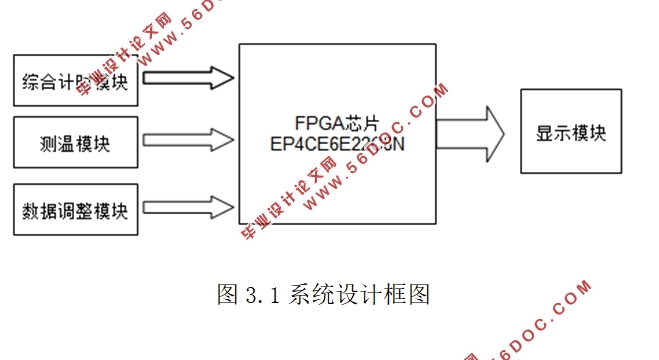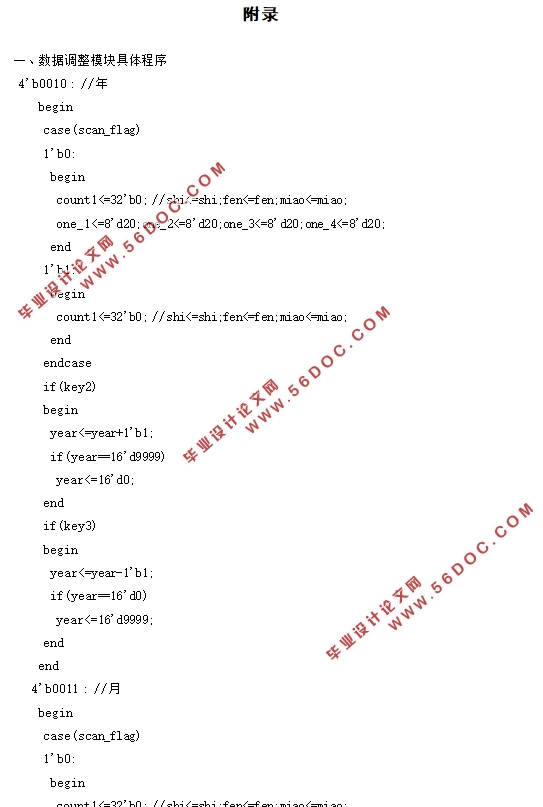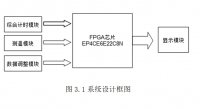基于FPGA的万年历设计
来源:56doc.com 资料编号:5D21118 资料等级:★★★★★ %E8%B5%84%E6%96%99%E7%BC%96%E5%8F%B7%EF%BC%9A5D21118
资料以网页介绍的为准,下载后不会有水印.资料仅供学习参考之用. 密 保 惠 帮助
资料介绍
基于FPGA的万年历设计(论文15000字)
摘要:万年历在人们的生活中一直扮演着重要的角色,可随着时代的发展,传统的纸质万年历已经越来越无法满足人们对于时间精确度以及便捷性的要求。随着电子科学的不断发展与进步,各式各样的电子万年历也随之出现。本文在Quartus II环境下,运用FPGA芯片开发,Verilog HDL语言编程,来实现一个基于FPGA的电子万年历。选用FPGA来实现电子万年历的优势在于外围电路相对简单、系统的集成化程度高且设计过程也相对灵活,最重要的是在精度方面比之现在市场上的一般电子万年历也有着显著的优势。
关键词:万年历,FPGA,Quartus II,精度
Design of Calendar Based on FPGA
Abstract: The calendar has played an important role in people's life. With the development of the times, the traditional paper calendar has become increasingly unable to meet people's time precision and convenience requirements. With the continuous development of electronic science and progress, a variety of electronic calendar also appears. In this paper, Quartus II environment, the use of FPGA chip development, Verilog HDL language programming, to achieve a FPGA-based electronic calendar. The advantage of using FPGAs to achieve electronic perpetual calendar is that the external circuit is relatively simple, the system is highly integrated and the design process is relatively flexible. The most important thing is that there are significant advantages in precision than the general electronic calendar in the market today.
Keywords: calendar, FPGA, Quartus II,accuracy


目 录
1.绪论 1
1.1研究背景 1
1.2研究意义 1
1.3国内外研究现状 2
2.FPGA概述 2
2.1 FPGA简介 2
2.2 FPGA工作原理 3
2.3开发平台Quartus II概述 3
2.4 Verilog HDL语言概述 4
3.总体方案设计 5
3.1设计目标 5
3.2 系统设计方案 5
4. 系统硬件设计 5
4.1 FPGA最小系统模块 5
4.1.1 系统主芯片 5
4.1.2电源模块 6
4.1.3时钟信号模块 7
4.1.4调试接口模块 8
4.1.5复位模块 8
4.2温度测量模块 8
4.3显示模块 10
5. 系统软件设计 11
5.1 软件设计总思路 11
5.2 分频模块 11
5.3综合计时模块的软件设计 12
5.3.1公历闰年计算方法 12
5.3.2综合计时模块设计思路及实现 12
5.4数据调整模块的软件设计 15
5.4.1 数据调整模块的设计思路 15
5.4.2按键消抖的实现 15
5.5温度测量模块的软件设计 16
5.5.1 I2C通信协议 16
5.5.2温度测量模块的设计思路 18
6.系统调试 21
6.1硬件调试 21
6.2软件调试 21
6.3软硬件联调 23
7.总结 25
参考文献 26
致 谢 27
附录 28
|





